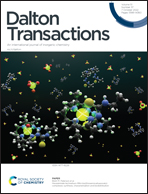Single component white-OLEDs derived from tris(β-diketonato) europium(iii) complexes bearing the large bite angle N^N 2-(4-thiazolyl)benzimidazole ligand†
Abstract
Two new organo-europium complexes (OEuCs) [Eu(tfac)3(TB-Im)] (Eu1) [Eu(hfac)3(TB-Im)] (Eu2) incorporating fluorinated (hexafluoroacetylacetone; Hhfaa) or hemi-fluorinated (trifluoroacetylacetone; Htfac) β-diketones together with the large bite angle N^N ligand (2-(4-thiazolyl)benzimidazole; TB-Im) have been synthesized and characterized. The structure of the complexes has been established by single crystal X-ray diffraction (SC-XRD) analysis and shows that the coordination sphere is composed of a EuO6N2 core (octacoordinated). Continuous shape measures (CShMs) revealed that the geometry around Eu(III) is trigonal dodecahedral with approximate D2d-symmetry. Efficient red emission is observed for both the complexes in solution with a fairly large photoluminescence quantum yield (PLQY (QLEu) = 39.00–47.00%). Furthermore, by utilizing the experimental photoluminescence (PL) data and theoretical modelling employing density functional theory (DFT) in conjunction with LUMPAC, energy transfer (ET) and back energy transfer rates were calculated, and an ET mechanism for the sensitized PL is proposed and discussed in detail. Finally, the complexes were used as an emitting layer (EML) to fabricate 20 organic light emitting diodes (OLEDs) by varying the doping concentration. Interestingly, both the complex-based OLEDs at 4 wt% doping concentration display white electroluminescence (EL) with the brightness (B) = 100.5–364.1 cd m−2 at very low turn-on voltage (Vturn-on) = 3.9–4.6 V. The overall electroluminescence performance of Eu1 and Eu2 is higher than that of the reported europium based single component white-OLEDs.



 Please wait while we load your content...
Please wait while we load your content...